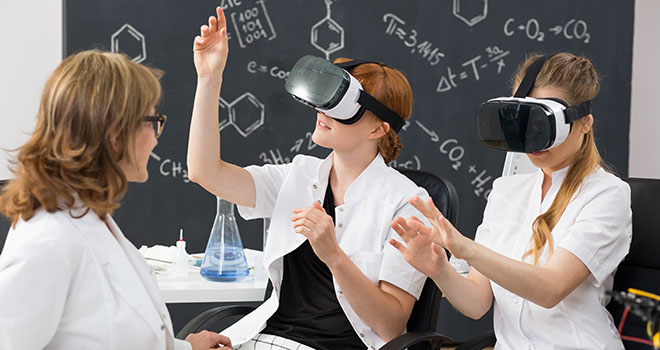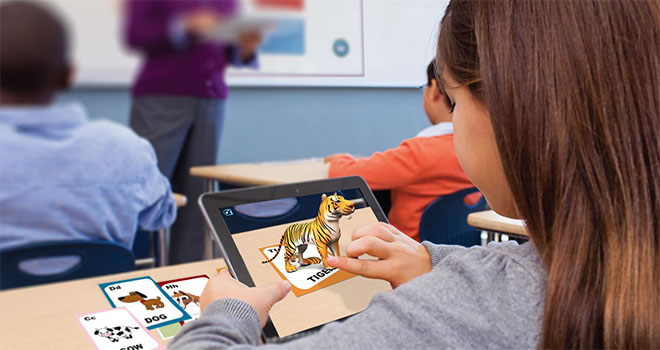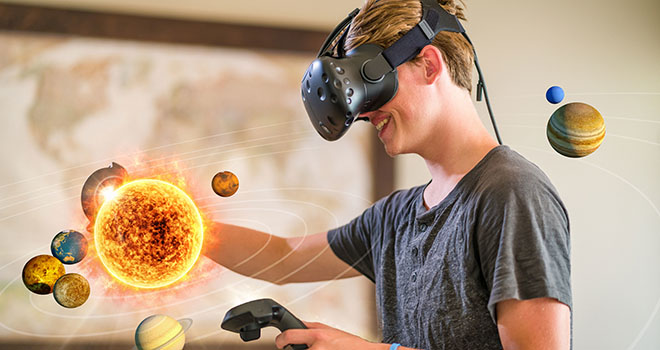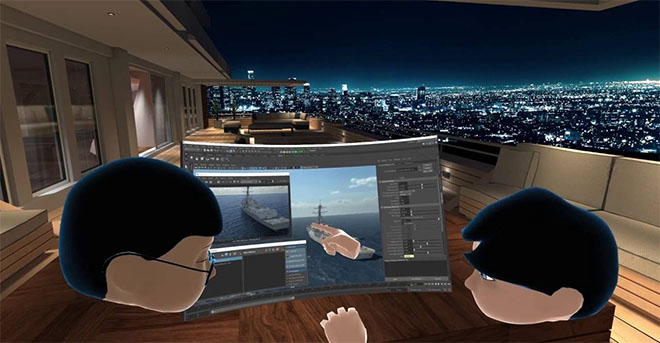VR, AR, and AI: The Future of Learning Experiences
Updated Sept 11, 2023 - Sophie Thompson
Traditional education systems have been implementing the same learning models for decades. Today, teachers are standing in front of their students just like they did a hundred years ago. Education is one of the few branches of work that has not experienced substantial change in the 21st century.
However, this is going to change with the emergence of Virtual Reality (VR), Augmented Reality (AR), and Generative AI. According to a recent survey, almost 70% of parents already think that AR can drastically improve education systems. Teachers also believe that new technologies can modify and enhance the learning experience as we know it today.
For example, VR can be accessed through specially-designed goggles that project an interactive world to the viewer, which could transform classical schools and the education system as a whole.

How will kids react to such enormous changes? What do teachers think about it? How about parents? Is it going to jeopardize work positions or slow down the socialization of future students? What about technical requirements of AR and VR classrooms?
There are plenty of questions to answer and a thorough analysis of this technology is needed. In this article, we explain why AR, VR, and AI represent the future of learning experiences.
The role of generative AI in learning
Before diving into the extraordinary realms of Augmented Reality (AR) and Virtual Reality (VR) in education, it's crucial to recognize the pivotal role that Generative Artificial Intelligence (AI) plays in shaping the future of learning.
At its core, Generative AI employs advanced neural networks to create dynamic content that caters to individual students' needs and preferences. Think of it as a personal tutor, available 24/7, capable of adapting to each student's unique learning journey.
1. Personalization beyond imagination
Generative AI goes beyond conventional teaching methods by offering a level of personalization that was once considered unattainable. Traditional textbooks and one-size-fits-all curricula have limitations.
Not all students grasp concepts at the same pace or through the same teaching style. With Generative AI, learning materials can be customized in real-time, ensuring that students receive content that aligns with their current knowledge level and learning style.
Imagine a scenario where a student is studying mathematics. Generative AI, fueled by machine learning algorithms, continually assesses the student's progress.
If the AI detects areas of struggle, it generates additional practice problems or provides alternative explanations until the student grasps the concept. Conversely, if the student is advancing quickly, the AI can introduce more advanced topics or challenges to keep them engaged and motivated.
2. Adaptive learning paths
Generative AI empowers educators to implement adaptive learning paths for their students. It can analyze students' responses to quizzes, assignments, and interactions with learning materials to create personalized routes through the curriculum. This approach ensures that students receive the right level of challenge and support, preventing boredom or frustration.
For example, in a language learning application enhanced by Generative AI, the system can assess a student's vocabulary and grammar proficiency.
If a student excels in vocabulary but struggles with grammar, the AI may recommend tailored exercises and resources to address the grammar deficiency. As the student progresses, the AI adjusts the difficulty level accordingly.
3. Real-time feedback and assistance
Generative AI doesn't just offer personalized content; it provides instant feedback and assistance. Students no longer need to wait for a teacher's response or corrections; they receive real-time guidance. This feature not only accelerates the learning process but also boosts students' confidence as they can immediately rectify mistakes and reinforce correct understanding.
In a science class, for instance, a student might be conducting a virtual experiment in a VR environment. Generative AI monitors the student's actions, identifying misconceptions or errors in the experiment.
Instantly, the AI provides feedback and suggests adjustments. This iterative process ensures that students learn through their mistakes, which can be a powerful educational tool.
4. Continuous improvement
Generative AI doesn't stop at personalizing content; it also enhances the teaching materials themselves. Over time, as it collects data on how students interact with various learning resources, it can optimize those resources for maximum educational effectiveness.
Consider an online history course enhanced by Generative AI. As students engage with the course materials—textbooks, videos, interactive timelines—the AI tracks their preferences.
If students show a preference for video content to learn about historical events, the AI might generate more video-based modules. If students respond positively to interactive timelines, the AI can create additional interactive content to reinforce understanding.
5. Accessibility and inclusivity
One of the most promising aspects of Generative AI in education is its potential to make learning more accessible and inclusive. For students with diverse learning needs, including those with disabilities, AI-powered tools can adapt content to accommodate their requirements. This fosters a more inclusive learning environment where every student can thrive.
For instance, a visually impaired student studying literature can benefit from Generative AI, which can convert text into audio and provide detailed audio descriptions of visual elements in literary works.
Simultaneously, the AI can adapt the reading pace to match the student's preferences, ensuring comprehension without unnecessary rush.
In essence, Generative AI transforms the entire educational landscape, making learning a highly adaptive, personalized, and inclusive experience.
It empowers both students and educators to embark on educational journeys that are uniquely tailored to individual needs and aspirations, paving the way for a more equitable and effective education system.
The definition of augmented and virtual reality
By definition, VR is the term used to describe a three-dimensional, computer-generated environment which can be explored and interacted with by a person.
That person becomes part of this virtual world or is immersed in this environment and whilst there, is able to manipulate objects or perform a series of actions to determine what happens in the environment. VR technology relies mostly on headsets, also known as goggles.
On the other hand, AR is an enhanced version of reality where live direct or indirect views of physical real-world environments are augmented with superimposed computer-generated images over a user's view of the real world, thus enhancing one's current perception of reality.
To put it simply, users see layers of digital information covering real world images, which improves their overall experience of reality. The most common versions of AR are these:
- Location-based AR: This system provides users with additional information based on his or her geolocation. It has an incredible application potential in automobile industry and transportation in general.
- Projection-based AR: In this case, AR software sends light to the physical object to create an interactive dashboard in the real-time environment.
- Superimposition-based AR: This type of AR allows users to completely or partially replace the actual image, adding new elements to the viewpoint. It's perfect for the fashion industry, architecture, and design.
AR and VR: The current state of affairs
Numerous studies prove that the VR and AR industry is on the rise. The potential in this field is enormous and companies are investing millions just to get a foot in the door. The technology will play an essential role in the near future.
Closed and open learning systems
Technology-based teaching promotes personalized learning as a way of getting the best out of each student. It offers a customized learning experience, allowing pupils to study at their own pace. Using AR or VR gadgets, everyone can take lessons both in and out of school, which is an excellent solution for kids who don't have enough patience to follow the pace of their classmates.
In terms of teaching methodology, we can distinguish between two different systems – closed and open learning. One system is based on VR headsets, while the other relies on AR solutions. Let's discuss the essentials of both methodologies.

Closed learning system
A closed learning system uses VR headsets as the mean of studying. The logic is simple: students put on their headsets and enjoy interactive 3D lessons on their own. We call this teaching method closed because it isolates the subject from external influences, putting emphasis on individual work.
Such a system has numerous advantages but also a few setbacks. We will go through its most important features:
- Focus on one subject: VR headsets completely overwhelm students and force them to concentrate on one subject of studying 100%. This is great because kids don't lose attention and remember most of the data immediately.
- Connects theory and practice: VR technology enables young learners to see or feel everything they've read about in theory. For example, they can watch how cells divide or atoms split, which sounds almost unimaginable even today.
- Gamification elements: Children learn well while playing, which makes VR equipment the most amusing studying tool in the history of education.
- Alienation: If students spend a lot of time learning through VR headsets, they will forget that interpersonal communication is one of the cornerstones of successful education. Schools don't only teach kids math and languages but also prepare them for real life experiences and human interaction.
- VR takes over control: What is the role of a teacher if pupils can consume VR content all day long? Professors are still the ones who should assess and evaluate the knowledge and personalities of their students, while headsets should remain but an instrument of studying.
- Limits decision making: In a closed learning system, students follow the path predetermined by the developer. They can rarely go outside already established patterns, ask questions, and initiate real-time discussions with classmates. This is not good because the whole purpose of education is to form rational and free-thinking individuals.
Open learning system
An open learning system is based on context-driven algorithms, using AR technology as the tool to support and improve everyday studying. Such technology is able to collect external information coming from teachers, peers, and individual users. Doing so, AR keeps improving the learning processes and adapts so as to fit the requirements of each child individually.
AR adds value to the courses because it recognizes when it is time to show contextual information related to the studying subject. For instance, AR tools can add layers of digital information to give further explanations about the formula a math teacher wrote on the blackboard. This way, kids who didn't pay attention or couldn't figure out everything at once can go back and reconsider an entire mathematical expression.
But AR has another purpose and that is to collect and analyze data about the progress of every student, sending valuable reports to teachers, psychologists, counselors, and career advisers. At the same time, AR technology can design a quick test or quiz to keep an eye on the overall level of knowledge in the classroom.
In case teachers want to adjust the program for some students, they can give input to the AR system to increase or decrease difficulty. This will help weaker pupils to learn as much as possible or allow excellent kids to learn even more and fulfill intellectual potential.
However, teachers are not the only ones who can give feedback. On the contrary, students can also express their opinions and say when the pace is too fast or too slow, requesting adjustments to the course. Since we've discussed the traits of the closed learning system, we'll now cover the benefits of the AR-based methodology:
- Studying support: Unlike VR headsets, open systems do not take full control over teaching process. Instead, AR helps both the teachers and young learners to study more productively by displaying a variety of contextual information whenever necessary.
- Boosts interaction: If VR technology is isolating users, AR is doing exactly the opposite. The system actually boosts interaction because it allows all kids to engage and make comments about the current topic of interest.
- No control loss: Even if schools accept AR technology, it will not diminish teachers' role in any way. They get to stay in charge and make all important decisions, while digital projections of course-related information can only make the learning process more interesting and appealing.
- Feedback can be wrong: We mentioned that AR devices should also collect information from teachers, counselors, and students. This could sometimes cause a little confusion because no one can make sure that all participants will always give correct and reliable information. This is a small concern but definitely not enough to make you worry about the efficiency of AR in education systems.
Real life examples of AR and VR usage in the classroom environment
The practical value of AR or VR in the learning experience means nothing without examples. Everyone should understand how new technologies will help teachers to share knowledge with their students more productively.

A virtual lecture in the Engage VR application. Students from around the world can attend and learn together.
Below you will find a list of fields and the corresponding examples of AR and VR usage in the classroom environment.
- Healthcare: Not so long ago, the only way to learn how healthcare works was to join the game in real life and become an apprentice in the local hospital. Today, it is possible to take part in virtual surgeries and other medical treatments to earn valuable experience without hurting anyone. Thanks to VR and AR technology, healthcare learning is gradually becoming much safer and faster.
- Chemistry: Children can hardly think of anything more annoying than mind-boggling lessons about molecules and subatomic interactions. In the age of augmented and virtual learning, things will change rapidly. Kids will get the opportunity to conduct experiments on their own, mix substances, and learn about chemistry through first-hand experiences. This is not only safer but also cheaper than traditional laboratory experiments because schools won't have to pay for various chemical substances anymore.
- History and Geography: Students often enjoy stories about ancient Greece, Egypt, or Mesopotamia but it's difficult to learn and memorize so much information about people, things, and events substantially different than those we know today. However, if you add a little bit of AR magic to history and geography lessons, it will be interesting even for the most demanding pupils in the group. Virtual field trips require less time than traditional field trips - usually 30 minutes to an hour. They also demand less planning and less money. Just try to think how an average high school kid would feel visiting the Great Wall of China from his classroom in Boston, Massachusetts. Amazing, right?
- Physics: It's important to teach kids classical mechanics and Newton's law of motion, but what if you could give them a chance to put theory into practice in the VR environment? If you teach about astronomy, light years, and faraway galaxies, why don't you take kids to interstellar journeys? This may sound like a science-fiction scenario but it's not far away from becoming a reality. AR technology can make it happen in a matter of years, so our kids will definitely experience more impressive studying methods than us.
- Manual work: Manufacturing involves some serious tools and heavy machinery, which is not really practical for the traditional classroom environment. Using VR headsets, you can let children drive trucks, drill holes, or build homes without being afraid that someone will get injured in the process. The same goes for firefighting missions, coast guard activities, and a wide variety of similar jobs.
- Art and Culture: There is a mobile app called Prisma that transforms photos and videos into works of art using the styles of famous artists such as Edvard Munch, Vincent Van Gogh, or Pablo Picasso. It's a perfect example of how superimposition-based AR can stimulate people to play and simultaneously learn about the history of art and culture. With VR goggles, you can also attend a ballet, opera plays, concerts, and other events remotely to get the notion of current cultural trends. Even more, you can virtually go back in time to watch the original Shakespeare play in the 16th century London - there are no limits for new technologies in education.
- Languages: The easiest language learning method is going abroad and talking to native speakers. So far, this type of studying was the privilege of individuals coming from wealthy families but even they couldn't spend too much time abroad. Tomorrow, everyone will have the opportunity to 'visit' France or Japan and learn foreign languages and local cultures on site.
The list of potential applications of AR and VR in education cannot be reduced only to these 7 fields of interest. On the contrary, there are many more things and subjects to consider in that regard but we only wanted to give you the first impression.
We will, however, add an extra note here – AR and VR can be used to design a virtual classroom with students from all over the world. This classroom could welcome the most respectable lecturers, elevating long-distance learning to the whole new level. We are still far away from making it happen on a regular basis but the idea itself sounds incredible.
Pros and cons of AR and VR driven learning
We have so far defined virtual and augmented realities, saw the current state of affairs in this field, explained the mechanisms behind both models, and discussed some of their basic applications in education. Let's now give a final overview and reveal pros and cons of using these technologies in modern classrooms.

Pros
- Testing: We mentioned already a few great examples of AR training, medical surgeries included. Students can practice as much as they want and keep repeating until they are 100% sure about how to perform the task. Education will produce high-quality workers, while the number of human errors will be reduced.
- Interaction: AR learning doesn't only help pupils to study. It gives them the opportunity to engage, too. With so much contextual information displayed around the classroom, it is getting easier to follow lectures, understand complex themes, and speak your mind about it all.
- Learn anywhere, anytime: Long distance learning is not a new thing but AR and VR have taken it one step further. Tomorrow's students will be able to attend virtual classes and online courses from the comfort of their homes. They also get to choose the timing, setting the studying pace that fits a specific daily schedule. All this makes the future learning experience cheaper, faster, and more productive.
- Career choices: In the age of virtual reality, each high school kid will get the opportunity to test various industries and decide what seems to be the ideal career for him or her. Making a career choice will not be as stressful as it used to be and students will make less wrong decisions along the way.
- Gamification: Gamification elements increase engagement rates in classrooms, stimulating kids to participate in practical tasks and the corresponding debates. Studying through games already proved to enhance children's learning capabilities but the results are expected to be even better with the help from AR and VR tools.
- Variety: VR and AR allow personalized learning but they also enable students to choose from a wide variety of courses. They don't necessarily have to pick the existing courses in any given school since there is a bunch of credible online classes that can suit certain pupils more than traditional courses.
Cons
- Isolation: Learning based on VR goggles can alienate students and reduce interpersonal communication among peers. For this reason, it is better to use headsets occasionally as part of the learning experience, rather than using it for the whole day.
- No control: New technology enables teachers to share knowledge with their pupils much quicker and more efficiently. However, tools based on artificial intelligence are getting smarter each day and there is a danger they could make professors feel unwanted or obsolete. Of course, this is not the problem at the moment but VR and AR are evolving quickly and it could happen relatively soon – perhaps in 10 or 15 years.
- Discipline: As students will get the possibility to learn anywhere and anytime, it could reveal the problem of self-discipline. Namely, it is difficult to force kids to study even with the help of the most advanced IT tools. Teachers will have to pay special attention to this issue and control the learning process continuously.
- Abundance: Modern pupils will learn things faster using AR or VR gadgets but they will receive and memorize much more information than today's kids. With such an abundance of learning materials, it will be important to leave enough time for real life unplugged communication.
- Accreditation: Education systems are changing very slowly and it will take a long time before schools, systems, and entire countries begin accepting the benefits of AR technology in everyday teaching practice.

Social VR will play an important role in reducing student isolation while in a VR headset. Screenshot from BigScreen VR application.
VR/AR may have some downsides, however there are so many features that make this technologies attractive - there is no reason not to start gradually involving and trialing them in education systems. The process will be slow and probably painful on some occasions but it will bring incredible benefits to the educational system in the long run.
When VR/AR and Generative AI come together
When Virtual Reality (VR), Augmented Reality (AR), and Generative AI converge in the realm of education, they form a transformative synergy that promises to reshape learning experiences.
This integration facilitates hyper-personalized learning, with Generative AI tailoring educational content and simulations within VR/AR environments to suit individual student needs and learning paces.
Dynamic scenario generation transports learners to immersive, interactive educational settings, enabling hands-on exploration of subjects.
Adaptive assessments, natural language interaction with virtual tutors, and the generation of supplementary resources enhance engagement and understanding.
Learning analytics provide educators with valuable insights for informed teaching strategies. While challenges such as socialization and the evolving role of educators need addressing, this fusion holds immense potential to create a more engaging, inclusive, and effective educational landscape.
Conclusion
Education systems traditionally refused to accept technological changes and most of them still rely exclusively on the 'teacher in front of the kids' strategy. However, the time has come to embrace new teaching models, where virtual and augmented reality can play an important role.
Using AR tools or VR headsets, students will be able to experience learning in a completely new way. They can organize virtual field trips, visit historical places, conduct experiments, and test a wide range of devices. VR and AR technologies add gamification elements to classical education, making the whole process more appealing and engaging.
At the same time, learning becomes more inclusive, accessible, and affordable. Soon enough, AR gadgets will be so cheap that almost everyone can use them on a daily basis. But there are also a few side effects as well.
Too much of VR can isolate pupils and affect their socialization with other children. Additionally, professors will at least partly lose control over the teaching process. The technology still needs to acquire accreditation from state authorities to become fully operational.
However, all these obstacles cannot change the fact that AR and VR will play an important role in the future of learning.


